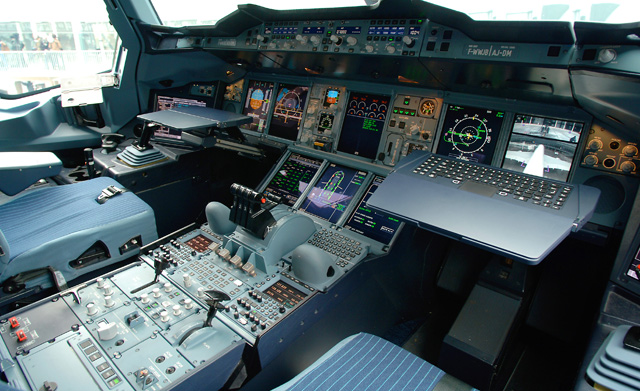Aircraft manufacturers intend cockpits to be paperless soon. Airbus, for example, says it intends its aircraft to be completely paperless – therefore totally electronic flight bag-dependent – within two years. But they all face a permanent dilemma about what interface they should choose. Boeing with its 787 and Airbus with the A380 and A350 have onboard information systems (OIS) that are fully integrated with the aircraft’s avionics, and the need for pilots to use tablet computers during the flight has been eliminated. Everything the pilots need for flight, including manuals and charts, is there.
The trouble with this Class 3 equipment is that, however capable, it is expensive and, as part of the aeroplane, needs airworthiness certification, which means updating is slow, and the permanent risk exists that its capabilities will be overtaken by hardware and software advance of commercial off-the-shelf (COTS) technology – like advanced tablet computers with commercially developed aviation apps – which is much cheaper. Airbus customer cockpit support specialist Xavier Lesceu reveals that the company is looking at developing a secure wireless link for the flightdeck, alongside the open wi-fi for the passengers, which could effectively make Class 1 EFBs into Class 2 devices without needing a docking station. They would also be able to link into the aircraft’s external communications, whether ground-based datalink or satellite communications.
But at the moment, Airbus chief test pilot Peter Chandler is clearly completely happy with the embedded OIS in the A350 and A380. Pilots have a toggle switch that can take them between the secure part of the OIS – the avionics, performance and technical side – and the ordinary external EFB function, which contains all the things the pilots used to carry in their old briefcases: charts, approach plates, manuals, checklists, controller-pilot datalink communications, frequencies, and company interfaces for rostering and other human resource issues. Chandler explained the relationship between the portable EFB and the integrated onboard information system (OIS) in Airbus’ two latest types. “The 350 and 380 both have an integrated screen for the OIS, but what is displayed can come from two different sources: the avionics world - maintenance functions, ACARS, Technical Log Book etcetera - or the open world EFB, meaning charts, manuals, performance apps and such like. With the integrated OIS the EFB functions are provided by a commercial off the shelf [COTS] laptop which is linked to the OIS by a docking station. This link is the function of the docking station - it is not to transfer data to a personal tablet.”
Chandler added: “For aircraft without an integrated OIS, the EFB functions are now often provided by a COTS tablet computer. “

The A380 has on onboard information system that is fully integrated with the aircraft's avionics
Airbus
Boeing is very positive about tablet EFBs: "They are economical and help close fleet-wide business cases. The devices and apps are convenient, enhancing pre-flight preparations and post-flight analysis. Usability in the cockpit is proven, including information access during critical phases of flight.
“Hardware design and operating systems are always improving, and an airline can realistically build 2-4 year EFB refresh cycles into their programme. Providers are showing unprecedented innovation in their apps."
Indeed, the market response to tablet-based EFBs is something Boeing has clearly taken on board: "The market has responded overwhelmingly. For example, we estimate over 100,000 professional pilots worldwide are using iPad EFB for paperless access to Jeppesen charting information, and we are excited about growth we are seeing in our new FliteDeck Pro for Windows tablets."
Boeing describes the dilemma for the aircraft manufacturers: "Traditional Class 2 and 3 EFB systems also have strong benefits, while simultaneously being challenged by the business case – particularly in the retrofit market.
“We see many loyal and happy users of Class 3 EFB systems, which we believe will continue to play an important, although evolving role."
But what of the future as Boeing sees it? Like Airbus, the company is also enthusiastic about onboard wireless connections: "Looking forward, the trends are emerging pretty clearly. Portable EFBs will continue to shift the game. These will be better mounted with power, and have access to aircraft systems through onboard servers, aircraft interface devices and onboard wireless.
“Add to that wide-spread onboard connectivity to the ground, and many longstanding dreams in our industry will come to full bloom."
Pilots love their toys, and the tablet computer has been a major success with aviators.
Source: Flight International























